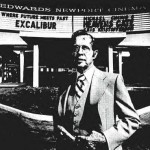Tags: Comments Off on Tis’ The Season For Openings
Tis’ The Season For Openings
December 24th, 2008 by
Respond
AMC Fullerton Anniversary
December 18th, 2008 by
Respond
Tags: Comments Off on AMC Fullerton Anniversary
Anniversary of Excess
November 15th, 2008 by
Respond
Tags: Comments Off on Anniversary of Excess
A Peek Behind The Scenes
November 4th, 2008 by
Respond
Tags: Comments Off on A Peek Behind The Scenes
Uncertain Future In The Digital Era
October 18th, 2008 by
Respond
Earlier this month, five Hollywood studios agreed to a deal with Digital Cinema Implementation Partners, a consortium of the “big three” cinema chains (AMC, Cinemark, and Regal Entertainment Group), to help pay for a $1 billion-plus rollout of digital projection on roughly 20,000 movie screens in North America. The remaining major studios and a deal for smaller cinema operators are still in the works, but overcoming this initial hurdle basically signals that the long anticipated digital era is finally at hand.
Tags: Comments Off on Uncertain Future In The Digital Era
Groundbreaking To Grounded
September 28th, 2008 by
Respond
- In August of 1988, Mainplace held the Orange County exclusive engagement for “The Last Temptation of Christ”. The film’s religiously controversial subject matter saw all other county cinemas pass on the booking.
- In May of 1989, Mainplace set a new high in county ticket prices, with a $6.50 adult admission; in conjunction with the release of “Indiana Jones and the Last Crusade”.
- In October of 1990, Mainplace was among the first theatres to show an NC-17 rated film, with “Henry and June” (the first film to obtain the, then new, adult rating). The film’s Mainplace screening was the site of a well publicized protest by local activists.
- In October of 1998, Mainplace was the sole Orange County cinema to screen “Orgasmo”; an extremely limited release, NC-17 rated comedy, from the creators of the “South Park”, that lampooned pornography and the Mormon church.
Tags: Comments Off on Groundbreaking To Grounded
The $6 Milestone
September 27th, 2008 by
Respond
What will 25 cents buy these days? A first-class postage stamp and 3 cents change. A local call at a pay phone-forget the change. The morning paper at a sidewalk news rack. Or a cheap cigar.
Even twice the purchasing power won’t buy much. Four bits is about half a gallon of gas. Two hours’ grace on a parking meter (Newport Beach not included). Or a cup of coffee, hold the Kahlua.
Yet when it comes to movie prices, 25 or 50 cents becomes big money. Especially when it’s the difference between an adult admission price of $5.50 or $5.75 and $6, a barrier that has finally been broken in Orange County.
Although $6 movies are common in L.A., admission to most Orange County theaters has remained $5 to $5.50. The San Francisco-based Syufy chain’s eight-screen Cinedome complex in Orange upped the ante by 25 cents last spring on adult admissions to $5.75.
And then, with the Sept. 25 opening of the lavish new AMC theater complex in Santa Ana’s MainPlace shopping center, the $6 movie finally arrived. Of course, you can get in for less than six bucks-if you can pass for 13 or skip out of work early enough to catch reduced-price afternoon matinees or twilight shows. But the average working stiff is still going to have to shell out six big ones on a trip to AMC’s MainPlace.
How big a deal is an extra quarter or two to theater operators? Evidently, pretty big.
When queried about ticket policies, one normally talkative movie-biz official clammed up so tight you would think he was being asked to leak nuclear secrets to the Soviets. Executives at other major theater chains were more cooperative, but no less concerned about AMC’s strategy and prices in general.
“We have no plans in the near future to raise our prices,” said Joan Edwards, executive vice president of Newport Beach-based Edwards Cinemas, which dominates the Orange County movie market with about 80 screens and a top admission price of $5.50. “We want to keep them as low as we can and still run a business.”
To the average movie-goer, though, Edwards said, “I think (50 cents) makes a big difference.”
John Reutter-Harrah of Garden Grove agreed. “I was a bit shocked at the price,” Reutter-Harrah said Monday as he and his wife Susan were leaving MainPlace after seeing “My Life as a Dog.”
Added Susan: “We have to pay a babysitter, so it can really add up . . . . Our first choice is always a $2 theater.” Both said they would go back to the AMC, but, Susan said, “only if it’s a movie that isn’t playing anywhere else.” Like maybe New York City, where the news of $7 movie prices has surfaced in recent weeks.
Still, with wide, thick-cushioned seats, combination armrest-beverage cup holders, multichannel stereo sound, ceiling fans for air circulation and colorful art-deco interiors, AMC’s MainPlace theaters are a vast improvement over the stereotypically spartan cracker-box mall theater.
AMC is also venturing beyond the usual mall theater booking policy by offering Orange County exclusives (“My Life as a Dog,” “Slam Dance”) and limited run films (“Hail! Hail! Rock ‘n’ Roll”) as well as those in general release (“Best Seller”). And it was reassuring to find that along with all the high-minded fare shown during opening week festivities, AMC wasn’t above showing the future trash classic “Amazon Women on the Moon.”
“AMC has been concentrating efforts on what we refer to as `impact houses,’ and the Santa Ana MainPlace theaters certainly fall into that category,” AMC spokesman Ron Foreman said. “Our new Century City (14-theater complex that opened Oct. 9) is another good example. . . . By `impact houses’ we mean luxurious appointments and high profile situations in upscale malls. That’s the kind of place AMC wants to be in.”
If you still think $6 is just too much for a movie, try thinking of it as one cultural advantage Orange County has over New York. Or, at least, as a great excuse for giving up those cheap cigars.
Tags: Comments Off on The $6 Milestone
Tis The Season For Endings
September 19th, 2008 by
Respond
September holds a rather dubious place in the history of Orange County drive-ins, as four of the county’s outdoor cinemas were closed during this month; the previously outlined Mission Drive-In (9/8/85), the La Habra Drive-In (9/10/89), the Orange Drive-In (9/11/94), and the Stadium Drive-In (9/12/96).
Tags: Comments Off on Tis The Season For Endings
Mission Drive-In Closure
September 10th, 2008 by
Respond
Tags: 1 Comment
The Deal That Almost Was
September 7th, 2008 by
Respond
Tags: Comments Off on The Deal That Almost Was






